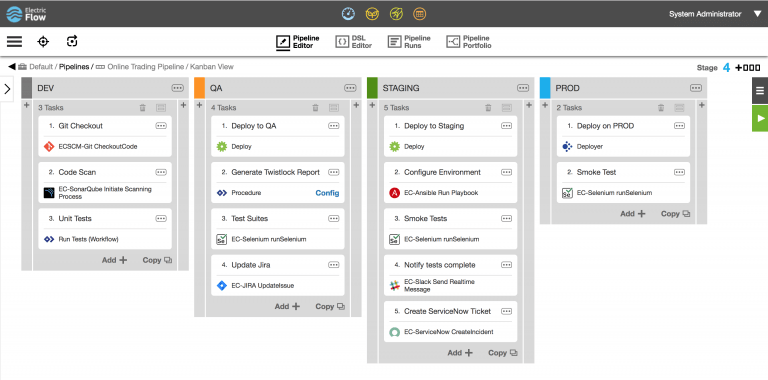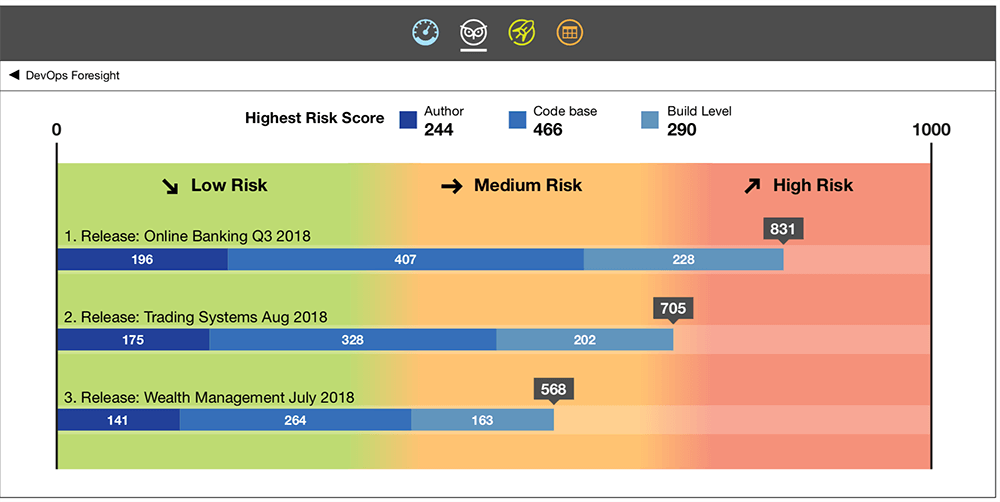Electric Cloud Fuels DevOps in 2019 with AI, Analytics and Cloud-Based SaaS
In 2019, DevOps will be a focus for companies looking to speed up software releases. Electric Cloud is offerings help on several fronts – with add-on features for analytics, AI, cloud-based SaaS options. IDN speaks with Electric Cloud CTO Anders Wallgren.
by Vance McCarthy
Tags: analytics, cloud, DevOps, ElectricFlow, insights, machine learning, SaaS,

CTO

"We combine key metrics with machine leaning to help users understand the bottlenecks, and where you can apply juice to create the most lift."
In 2019, DevOps will be a focus for many companies looking to speed up software releases. Electric Cloud is offerings help across several fronts – with add-on features for analytics, AI, cloud-based SaaS options.
IDN takes a look at 3 top features on offer in 2019 from Electric Cloud with CTO Anders Wallgren.
DevOps Foresight - Analytics, AI and Predictive Insights for DevOps
“There is an increased focus on value stream management in DevOps. So, these days, visibility is key – both into data and metrics for builds, as well as an ability to share those metrics with all vital team members,” Wallgren told IDN.
 Modern Application Development for Digital Business Success
Modern Application Development for Digital Business SuccessGiven the need for deeper and more granular analytics, Electric Cloud is bringing predictive analytics to DevOps with ElectricFlow DevOps Foresight. It identifies patterns using deep analytics of historical data from your tool chain, predicts the future risk of releases using those patterns and shows how to reduce that risk.
In specific, ElectricFlow DevOps Foresight is designed to predict the likelihood of a release’s success – even before it heads to production. “It also provides a “risk score’ to help users assess the likelihood of success for a particular build or pipeline,” Wallgren said. “We combine key metrics with machine leaning to help users understand the bottlenecks, and where you can apply juice to create the most lift,” he added.
ElectricFlow DevOps Foresight looks to leverage the vast amount of data created by DevOps toolchains. The idea, Wallgren told IDN, is that there is data coming from all sorts of different tools – and that data spans the entire software delivery process. “So, we built DevOps Foresight to capture all that varied data from customer, team and project-specific data in the DevOps toolchain. But more than that, leverage that data with AI and machine learning.”
This has several benefits – for developers, IT and even business users . “DevOps Foresight lets companies continuously reduce risk, cost and anxiety out of software releases. Bottlenecks and inefficiencies throughout the software delivery process are easier to find and correct,” Wallgren said.
With DevOps Foresight teams can achieve deep visibility into many pesky issues that can arise with software releases, including:
- identify patterns in release pipelines,
- gauge the likelihood of software release success,
- offer recommendations to improve pipelines when projects bog down, and
- determine if there are related projects (dependencies) that may be affected.
The Workings and Benefits of Machine Learning for DevOps
Wallgren listed some results from adding in AI/ML to DevOps Foresight. Among them:
- It frees up 30 percent of developer time used to support infrastructure.
- It eliminates operational silos as the root cause of cost, quality, and speed bottlenecks in DevOps.
- It can proactively address operational issues and minimize mean time to repair (MTTR).
Under the covers, DevOps Foresight combines vast amounts of data related to builds and pipelines (and captured from across the toolchain), along with AI and diagnostics. The result, Wallgren said, are ‘learnings’ that can be used by DevOps teams to stay on track or avoid mistakes or delays.
DevOps Foresights helps team answers many top-of-mind questions related to the success – or failure – of software releases.
Are we going to finish our release on time?
Can we move faster or can we do more?
Will this release cause more or less quality issues?
What’s the likelihood of a production deployment failure?
“The ‘learnings’ are based on a combination of 16 years of ElectricFlow’s own data, data from open source projects (such as Spring Framework) and other sources,” Wallgren said. Once DevOps Foresight is deployed on customer sites, it can also take in that customers’ specific data to learn more patterns specific to their builds and pipelines, he added
“Most of our data is developer-heavy, and includes source code metrics, complexity, number of line changes, times a line has been changed and even how often a developer touches a piece of code,” Wallgren added.
All that data is then “trained” using models and machine learning to “find patterns,” he said. “Once customers get their hands on all this, and can look at their data, that stokes the fire – and because it helps them see answers they haven’t seen before to [projects] relevant to them,” he said. In 2019, DevOps Foresight will expand to capture and analyze data from downstream deployment and production, by accessing data from third-party tools, Wallgren added.
DevOps Foresight really shines when helping DevOps team deal with dependencies, noted Sam Fell, Electric Cloud’s head of marketing.

“When you have a team with 15 things in the [software] release train that's going to go out tomorrow, and one of the people says ‘Oh, we’re almost ready but number 15 has to come out of that package so I got to pull it.’ -- that’s a real problem,” he said.
“The big question then is ‘What happens to those other 14 items in your release train?’ How do you know which ones are going to be impacted by pulling item #15? Do you have to retest that whole release -- or can you just ship it?” DevOps Foresight is engineered to answer these types of questions, he said.
Electric Cloud’s ElectricFlow was cited by Enterprise Management Associates (EMR) Research as a “top 3´enterprise software product for AI/ML. EMA Research has found AI/ML the number one strategic enterprise IT investment priority in 2018.
“As organizations expand DevOps initiatives to include more and more applications and application teams, getting visibility into and balancing the risk-reward for each release becomes much more difficult,” said Torsten Volk, EMA’s managing research director of containers, DevOps, Machine Learning and Artificial Intelligence. “Electric Cloud ElectricFlow has automated the data collection and analysis of DevOps toolchain data, and is leveraging AI/ML to provide recommendations that ensure valuable software can be released at the shortest possible time with the lowest possible cost and risk.”
[The full EMA report is available here.]
In a statement, Electric Cloud CEO Carmine Napolitano said of EMA’s recognition: “By enabling data-driven insights about their software delivery toolchains and processes, [enterprise users] have the foresight to know a release’s success rate by looking at past successes and failures, build complexity, author profiles and more.”
ElectricFlow 8.5 Now Available as Cloud-Based SaaS
Electric Cloud is also adding a cloud-based SaaS option for its ElectricFlow on-premises ARO (Application Release Orchestration) product. ElectricFlow SaaS avoids on-premise costs and gives DevOps teams developing cloud-native or serverless applications a way to keep all their development pipelines and tools in the cloud. ElectricFlow SaaS can also seamlessly connect to on-premise servers and tools inside and outside of a firewall.

Both versions of ElectricFlow 8.5 sport several updates (1) a new Kanban-style pipeline view, (2) object tagging and (3) a new CI dashboarding capabilities.
The new Kanban view in ElectricFlow 8.5 provides an easy-to-use management and execution view of pipelines, stages and individual tasks on one screen. Connected directly to the automation and orchestration, users can approve and observe release progress with real-time pipeline and application deployment status, Wallgren said.
ElectricFlow 8.5’s object tagging supports custom reporting and enhanced searchability. In specific, tagging on all objects allows release managers and product owners to quickly and easily create more granular, real-world reports. In addition, universal data segmentation is now possible across any object type (applications, pipeline stages, environments, etc.) and replaces code-based report creation.
The new CI dashboarding creates data-driven visibility into CI processes and bottlenecks, so that architects and application teams have clear understanding of builds from within the release pipeline. ElectricFlow works with all CI tools, including Jenkins, Bamboo and Git to give teams unprecedented insight into the value, cost and risk associated with every release, eliminating the need for difficult, extensive custom coding with tools like Hygeia.
ElectricFlow 8.5’s latest updates “allows us to meet our customers where they are, and simply ‘plug-in’ unified governance and orchestration across an ever-changing array of tools, stacks, and processes . . . [and] eliminates much of the anxiety associated with releasing software when adopting new processes or trying new technologies,” said Napolitano in a statement.
A trial or demo of ElectricFlow 8.5 is available here.
More Training, Education with Electric Cloud University
In one other development, Electric Cloud continues to build on its focus on DevOps education with its training and certification program in partnership with The DevOps Institute. The initiative, called Electric Cloud University aims to “provide IT and DevOps professionals the skills and confidence they need to help drive digital transformations.”
Related:
- InfluxData's Latest Updates Optimize Time Series Data for Better Performance, Scale and Management
- Actian Zen 16.0 Update Simplifies Delivery and Boosts Performance of Edge, IoT Apps
- Virtana Infrastructure Performance Management Adds AI-driven Capacity Planning
- e2open’s Supply Chain SaaS Updates Help Firms Reduce Operational Risks with Deeper Visibility
- Report: Endor Labs Identifies 2023 Operational, Security Risks To Open Source
All rights reserved © 2025 Enterprise Integration News, Inc.


